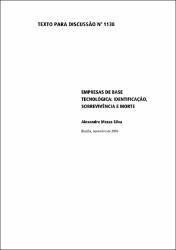Please use this identifier to cite or link to this item:
https://repositorio.ipea.gov.br/handle/11058/1650Full metadata record
| DC Field | Value | Language |
|---|---|---|
| dc.contributor.author | Silva, Alexandre Messa Peixoto da | - |
| dc.coverage.spatial | Brasil | pt_BR |
| dc.coverage.temporal | 1994-2001 | pt_BR |
| dc.date.accessioned | 2013-08-20T16:50:30Z | - |
| dc.date.available | 2013-08-20T16:50:30Z | - |
| dc.date.issued | 2005-11 | - |
| dc.identifier.uri | http://repositorio.ipea.gov.br/handle/11058/1650 | - |
| dc.description.abstract | A última década do século passado assistiu a uma mudança no entendimento da literatura econômica acerca das pequenas firmas. Se outrora elas eram percebidas como ineficientes em termos de produtividade e salários por operarem em uma escala de produção subótima, na última década elas passaram a ser encaradas como agentes de mudança tecnológica, fundamentais para a criação e a comercialização de novos conhecimentos. Esse novo entendimento veio a difundir na literatura as chamadas empresas de base tecnológica (EBTs). Porém, da mesma forma que essas firmas podem funcionar como agentes de mudança, percebe-se também que há uma grande rotatividade entre elas, com subseqüentes entradas e saídas. Dessa forma, traçou-se como objetivo deste trabalho a identificação de paralelos entre a teoria de sobrevivência da firma e a performance das EBTs brasileiras. Comparando-se a performance das EBTs criadas entre 1994 e 2001 com a do universo das firmas criadas nesse mesmo período, chegou-se a duas conclusões: i) as taxas de mortalidade das EBTs são menores que as do segundo grupo até o quarto ano, após o qual há uma convergência entre essas taxas; e ii) as novas EBTs apresentam um crescimento bem mais significativo que as demais novas empresas da economia. Ainda, com base no instrumental de análise de sobrevivência, chegou-se a mais três conclusões: i) as EBTs inseridas em setores com mercado em expansão apresentam maiores chances de sobrevivência; ii) uma maior ou menor concorrência não ajuda a explicar as taxas de mortalidade das EBTs; e iii) é indiferente o tamanho e o crescimento das EBTs para as suas chances de sobrevivência. | pt_BR |
| dc.language.iso | pt-BR | pt_BR |
| dc.publisher | Instituto de Pesquisa Econômica Aplicada (Ipea) | pt_BR |
| dc.title | Empresas de base tecnológica: identificação, sobrevivência e morte | pt_BR |
| dc.title.alternative | Texto para Discussão (TD) 1138: Empresas de base tecnológica: identificação, sobrevivência e morte | pt_BR |
| dc.title.alternative | Technology-based firms: identification, survival and death | pt_BR |
| dc.type | Texto para Discussão (TD) | pt_BR |
| dc.rights.holder | Instituto de Pesquisa Econômica Aplicada (Ipea) | pt_BR |
| dc.source.urlsource | www.ipea.gov.br | pt_BR |
| dc.location.country | BR | pt_BR |
| dc.description.physical | 22 p. : il. | pt_BR |
| dc.rights.license | É permitida a reprodução deste texto e dos dados nele contidos, desde que citada a fonte. Reproduções para fins comerciais são proibidas. | pt_BR |
| dc.subject.keyword | Empresas de Base Tecnológica (EBTs) | pt_BR |
| dc.subject.keyword | Teoria de sobrevivência da firma | pt_BR |
| ipea.description.objective | Identificar de paralelos entre a teoria de sobrevivência da firma e a performance das empresas de base tecnológica brasileiras. | pt_BR |
| ipea.description.additionalinformation | Série monográfica: Texto para Discussão ; 1138 | pt_BR |
| ipea.description.additionalinformation | Referências bibliográficas: possui referências bibliográficas | pt_BR |
| ipea.access.type | Acesso Aberto | pt_BR |
| ipea.rights.type | Licença Comum | pt_BR |
| ipea.englishdescription.abstract | The last decade witnessed a change in the view of the economic literature on small firms. If before they were perceived as inefficient in terms of productivity and wages, once operating in a suboptimum scale, in the last decade they turned out to be faced as agents of technological change, crucial for the creation and the commercialization of new knowledge. This new agreement came to spread out in literature the New Technology-Based Firms. However, in the same way that these firms may act as change agents, one also perceives that it has a great turnover between them, with subsequent entrances and exits. By this way, it the was traced as the objective of this work the identification of parallels between the theory of the firm survival and the performance of the Brazilian NTBFs. Confronting the performance of the NTBFs created between 1994 and 2001 to the one of the universe of firms created in same period, two conclusions were reached: (i) the rates of NTBFs death are inferior to the presented by the whole group of firms until the fourth year, after which a convergence between these taxes is witnessed; and (ii) the new NTBFs present a growth much more significant than the other group. Still, on the basis of the survival analysis instrumentals, more three conclusions were drawn: (i) the NTBFs from sectors in expansion present superior survival probability; (ii) a greater or minor competition does not help to explain the NTBFs rates of death; and (iii) neither the size nor the growth of the NTBFs are relevant for its survival possibilities. | pt_BR |
| ipea.researchfields | N/A | pt_BR |
| ipea.classification | Pequenas, Médias e Grandes Empresas | pt_BR |
| Appears in Collections: | Pequenas, Médias e Grandes Empresas: Livros | |
Files in This Item:
| File | Description | Size | Format | |
|---|---|---|---|---|
| TD_1138.pdf | 188.46 kB | Adobe PDF |  View/Open |
Items in DSpace are protected by copyright, with all rights reserved, unless otherwise indicated.

